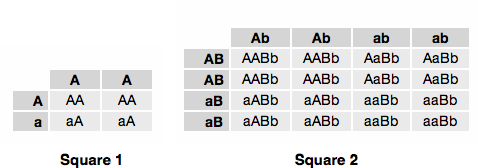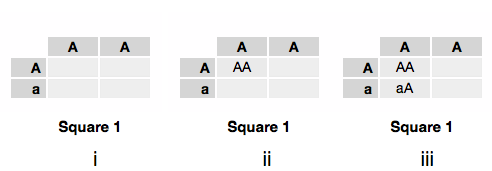Constructing a Punnett Square - Gametes
A
Punnett Square
is essentially a way to 'calculate' the outcome of
haploid gametes
gametes
combining to to form a
diploid
organism.
Let's look back at the Blue Brown Frog in which
allele
'A' is
dominant
(it is a capital!) and causes the frog to have brown skin, and the 'a' is
recessive
and produces an animal with blue skin.
Did you get the above quiz right? It is quite difficult to decide the outcome of a cross between two organisms, and this is where
Punnett Squares
come in.
Two
Punnett Squares
are shown in Figure 1 below, and
Punnett Square
1 could have been quite helpful in answering the above quiz as it shows a
Punnett Square
for a situation similar to the above question on the Blue Brown Frog.

Figure 1: Two Punnett Squares - Punnett Square 1 shows a simple 'one allele' situation and Square 2 shows two alleles - The parents for Punnett Square 1 would have been AA and Aa, and for square 2, Aabb and AaBB
To construct a
Punnett Square
you have to identify the possible
gene
combinations an organism could produce in the
gametes
and use those for 'axis' of the
Punnett Square
. In figure 1 these
gamete
combinations occupy the dark grey squares at the edge of each table, that is, the 'A' and 'a' (figure 1, square 1) and the 'Ab' (figure 1, square 2) etc., or as can be seen in the figure 2 panel i, below.

Figure 2: Punnett Square 1 - Figure showing a simple 'one allele' situation. The possible gametes are written along the top and the side, and then the square is completed by multiplying the axes. So, 'A' on the top and 'A' on the side gives 'AA' in the square - see panel ii; 'A' on the top and 'Aa' on the side gives 'Aa' - see panel iii
Figure 2 shows a simple 'one allele' situation. The possible
gametes
are written along the top and the side, and then the square is completed by multiplying the axes. So, 'A' on the top and 'A' on the side give 'AA' in the square - see figure 2 panel ii; 'A' on the top and 'Aa' on the side give 'Aa' - see figure 2 panel iii.
You have a male and female Blue Brown Frog, both of which are brown, and both of which carry a
recessive gene
gene
for blue....
Right, we now have the
gametes
identified, we can fill in the square...

